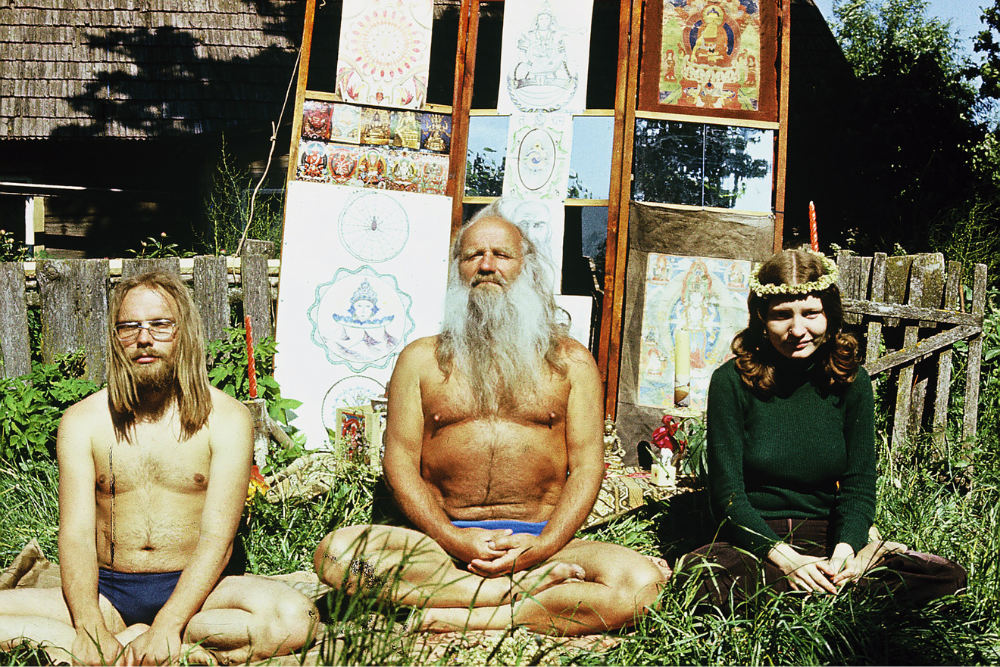
Where Are We Going? Back Into the Soviet Hippie Movement…

Courtesy of Vladimir Wiedemann
By Terje Toomistu
Who remembers the Soviet “Summer of Love”? Estonian anthropologist and documentary filmmaker Terje Toomistu brings back to mind Soviet hippies and their struggle for peace and freedom. The example of their passive resistance, by means of small gestures, offers perspectives in the current context of repression of pacifism, and opposition to the war of aggression in Ukraine.
The Soviet hippie protest and the anti-war sentiments in Russia
At the time when the hippies conquered Haight-Ashbury neighborhood in San Francisco and extensive student protests broke out in Paris, the bands with their never-before-heard psychedelic sound, the Beatles at their forefront, also converted a sizeable number of young people in the Soviet Union into the cult of peace and love. In fact, the Western hippies left a profound mark on the Soviet youth, triggering a movement which influenced several generations and turned out a distinct subculture in its own right.
In popular understanding, the history of the hippie movement has often been framed either as a form of protest against the status quo or as escapism – a hedonistic dive into psychedelia, meditative indifference, or oblivion with regard to the societal world. The central claim of the hippies’ insistence on freedom can be projected onto a similar binary: whether it was thought that freedom needs to be achieved through active engagement with the outside world – i.e. through protest – or it is inevitably an internal journey, in which only individuals themselves are responsible for their sense of freedom.
Broadly speaking, there were two distinguishable trends within the hippie movement. One was more interested in the cultural revolution, the other leaned towards political revolution. The first bunch defined the hippies in relation to certain music, hallucinogenic drugs, spiritual searches, colorful clothing, long hair, and a nomadic lifestyle, the second bunch formed the deeper currents of the movement, paving the way to significant political developments in civil rights, anti-war movement, environmental awareness and consumer culture criticism, feminism and the sexual minorities’ right for self-determination, and the fight against racism. In the Bay Area of San Francisco, for example, the first school gathered at the Haight-Ashbury, the second bundle centered around the university campus of Berkeley. For the first bunch, freedom was inevitably an internal process, while the others regarded active intervention and resistance as unpreventable. The former would have opted for escapism, the latter for protest.
Although both Western and Soviet hippies opposed the ruling order, the Soviet hippies were not inevitably—or not always—driven by political protest. What rather described them was a different emotional state and lifestyle, a sensory divergence from the rest of society. At a first glance, this may seem escapist, but the vast oral accounts from the participants of the Soviet hippie movement that I have gathered during the past decade when researching this while making the documentary film Soviet Hippies reveal a more nuanced story. It turned out that the escapist trends of the Soviet hippies appeared as a result of the politicization of the movement by the Soviet authorities during the narrow period between 1969-1971. This not only neutralized the desire for active intervention of society, but also the hope that an active protest would lead into anything productive. As a result of the surveillance and persecution that resulted from this politicization, they rather wanted to get as far as possible from everything they considered as political, so that society wouldn’t disturb them and they in turn wouldn’t disturb society. During the past decade in the socio-political landscape of contemporary Russia, this dynamic has reoccurred in frightening similarity.
Summer of love in the Soviet Union
So how did it all begin? Although the Soviet hippie movement turned out a unique subcultural phenomenon by the late 1970s and it lasted until the collapse of the Soviet Union, its initial impetus came from the turbulent 1960s in the West. The easing of the ideological pressure during Khrushchev’s thaw and the violent suppression of the Prague Spring in 1968 paved the way for the emergence of “locally brewed” hippie culture. The loss of faith in the possibility of having a “socialism with a human face” led to a widening gap between the formal and informal youth cultures. The kids tried to compensate the yawning gap between official expectations and their ideals with elements of fashion and music, the fragments of which had permeated the Iron Curtain from the West. Foreign radio channels leaked through the Iron Curtain, inspiring the young. The smuggled hippie-era records were exchanged among networks of friends and endlessly re-recorded on reel-to-reel tapes. In 1967, Estonian television reported that in Tallinn alone around eight public phone booths had been destroyed in a single day. The kids smashed the phones in order to steal the electromagnetic coils from the phone receivers and use them as pickup devices to turn their acoustic guitars into electric guitars—the case well illustrates their fanaticism. In absence of colorful clothing, self-tailored bell bottoms made of floral curtain fabrics became a new hit. The boys let their hair grow. “In a vacuum, even fart is air,” commented an Estonian cult poet Johnny B. Isotamm with irony.
While the Soviet propaganda machine aimed to forge a rigid Homo Sovieticus as the norm, for young people, the “West” signified the free world outside the zone, an imaginary and desirable “elsewhere,” the impact of which was further amplified by the knowledge that it was practically inaccessible. Still, the imaginary connection with the protesting youth in the West created an opportunity to experience at least some sense of freedom despite the restrictions.
Due to the historical context of Soviet occupation of the Baltics, the Baltic hippies were essentially against the Soviet rule, but this didn’t mean they would have constantly protested. Their passivity towards civic engagement could partly be explained by the ideas of pacifism and loving compassion. However, when these long-haired young people—perhaps just a couple of them in each classroom—soon became the target for the KGB, the very ways how the Soviet establishment treated them generated their “passive protest.” Anyone who portrayed a level of the hippie look was framed as potentially dangerous for the societal wellbeing and this led to various forms of diminishment and persecution. Over the course of just a few years, it became clear that even the smallest act of protest would either end badly or very badly.
This politicization of the hippies in Soviet Union took a telling form at the beginning of the 1970s during two significant events. In both cases, the hippies had socio-political ambitions, but they were suppressed by the authorities. The first attempt to organize a USSR-wide hippie gathering in Tallinn, the capital of Estonia, in the fall of 1970 was quietly shut off beforehand through surveillance of the suspected organizers and targeted warnings. Aare Loit, for example, was then a 10th-grade boy in Tallinn when he noticed suspicious men following him to school every day. He was soon invited to the teacher’s lounge to be warned about the gathering’s possible consequences on him as well as on his family’s wellbeing. Half a year later in Moscow, there was a historic gathering of the hippies on the 1st of June in 1971. Their stated aim was to protest against the War in Vietnam—the goal well in line with the official ideology of the time. However, the gathering ended with mass arrests, followed by targeted persecution of its perhaps as many as 2000 participants for months to come.
After these events, it became clear to the hippies that there was no point in actively protesting. There was the implanted fear since the Stalin era that they were constantly being watched, as if there was “an eye” on everything. Instead, the hippies tried to remain invisible. “It’s better to step into shit than into politics,” became a saying among the hippies by late 1970s. A message scribbled on the wall of a hippie apartment perfectly encapsulated their attitude: “We don’t disturb society and society shouldn’t disturb us.” The resistance of the Soviet hippies rather took a form of symbolic and sensory divergence, an aspiration to simply be “elsewhere.” The deeper divergence away from the activist and socially engaging stances, however, simultaneously created radicalization amongst them, often with considerably more vulnerable lifestyles.
Lessons from the legacy of the hippies
In the intervening half-century, it is all the more important to acknowledge the long history of pacifism in that part of the world, given the vital significance of the anti-war sentiments in the backdrop of the ongoing brutal war in Ukraine. Witnessing how even the smallest acts of protest in contemporary Russia—standing with the signs stating just “two words” or giving away George Orwell’s 1984 books for free—were met with harsh persecution, we need to support the resistance as well as the awareness of the people in Russia. In a similar vein, Soviet hippies could not take their protests to the streets, write to the media or hold rallies. It was just too dangerous and would not have led to productive developments. However, they established their views through active circulation of knowledge, by remaining true to their dreams and ideals, and most importantly, by sustaining their humanity. In doing so, they inspired others, shaping alternative mindsets and places that mutated and multiplied, until this multiplicity of differences chewed through the entire regime. When people die in mass and women and children are abused every day in Ukraine, the miniscule acts of everyday resistance which may lead to the collapse of the regime some time in future, seem nothing like enough.
However, if there’s something to learn from the legacy of the Soviet hippies, is that the passivity of resistance is so ingrained in fear and the feeling that action would not create the desirable change. Yet when difference to the status quo is enacted through even the smallest activities or simply by shifting of the mindset, and even if the expected change is not yet seen as coming, it is still important. Because this also creates a change.
Dr. Terje Toomistu is an anthropologist and a documentary film-maker, a Research Fellow at the University of Tartu’s Department of Ethnology, whose prime areas of focus are gender, mobility, and affect. She received her PhD degree in Ethnology. She has been a Fulbright Fellow at the University of California Berkeley and a visiting researcher at the University of Amsterdam, Department of Anthropology. She has also lived and studied in France, Russia, and Indonesia. Toomistu’s major research projects cover Indonesian gender and sexuality and the late Soviet non-conformist youth. With a filmography including “Homing Beyond”(2022), “Veins of the Amazon”(2021, co-directed with Alvaro Sarmiento and Diego Sarmiento), an award-winning “Soviet Hippies” (2017) and “Wariazone” (2011, co-directed with Kiwa), her work as a documentary film-maker has been featured widely in international press, including The Guardian and The Economist.


